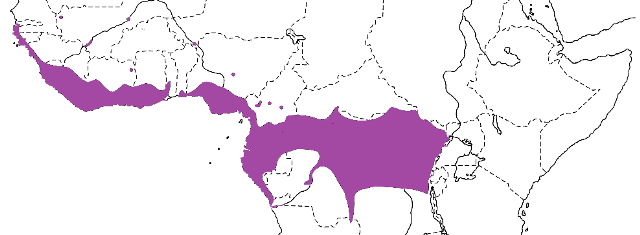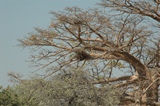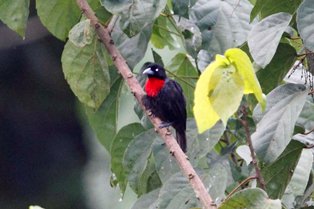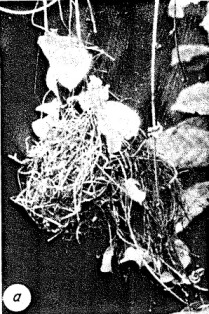Weaver news
|
The Blue-billed Malimbe is black with a scarlet patch on the throat and upper breast (photo right, enlarged from phown 984). The blue bill is slightly curved. The female is similar to the male but is slightly duller, and the immature bird is browner with a dull orange patch.  The Blue-billed Malimbe has no subspecies, although two were proposed in the past. It is found from Senegal to western Uganda and northern Angola, as shown in the map (above, from Birds of Africa). The Blue-billed Malimbe is solitary or found in pairs or family parties. It climbs tree limbs like a woodpecker, while foraging for arthropods.
This species is monogamous and the male builds a new nest every season. Old nests may survive for several years so that a few nests may be clustered nearby. Sometimes several pairs form loose colonies. The nest is ball-shaped, made of strips of epiphytes, palm fibres, twigs and tendrils (see photo right, from Collias NE, Collias EC. 1964. Evolution of nest building in weaverbirds. Univ. Calif. Publ. Zool. 73:1-239). The nests often overhang forest rivers and ponds. A remarkable nesting association has been found in this species. They like to build their nests in the vicinity of dens of the Central African Dwarf Crocodile Osteolaemus tetraspis, presumably because the presence of crocodiles keeps predators away. There is one PHOWN record for this species - see phown 984 and click on Large photos to see the nests (partially hidden by leaves), adult and juvenile. There are no PHOWN records for any other Malimbus species. Please look out for nests of this species and submit to PHOWN (PHOtos of Weaver Nests) via the Virtual Museum upload site. PHOWN records for this species Previous Wedn: Red-billed Quelea Full weaver species list |











 The Blue-billed Malimbe Malimbus nitens is in the genus Malimbus, which contains ten species. The origin of the genus is after the town of Malimbe, Angola, where the first Malimbe (a Crested Malimbe) was collected in around 1800. Malimbes are forest loving weavers found largely in central and West Africa. They are black weavers with patches of scarlet, orange or yellow. Males and females are dissimilar with different sizes or intensities of the coloured patches. They are almost entirely insectivorous, and live mostly high in trees. Their nests are neatly woven and some have long entrance tunnels.
The Blue-billed Malimbe Malimbus nitens is in the genus Malimbus, which contains ten species. The origin of the genus is after the town of Malimbe, Angola, where the first Malimbe (a Crested Malimbe) was collected in around 1800. Malimbes are forest loving weavers found largely in central and West Africa. They are black weavers with patches of scarlet, orange or yellow. Males and females are dissimilar with different sizes or intensities of the coloured patches. They are almost entirely insectivorous, and live mostly high in trees. Their nests are neatly woven and some have long entrance tunnels.
